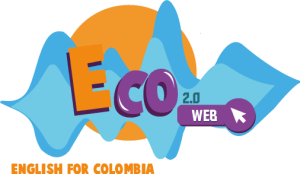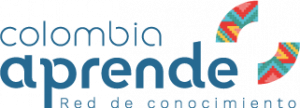National ELT Resources Repository
Browse more than 3,000 contents to teach and learn English. Search for the best resources by typing your key words here and use the filters to search in the National ELT Resources Repository.

Teaching Guide: Places of the neighbourhood
Author: Juan Carlos Sierra Villarraga – Description: This lesson plan provides students with the chance to talk about places of the neighbourhood and its corresponding location. Even though students are encouraged to develop the four skills, they need to pay special attention to a conversation in order to locate places and they are expected to describe their neighbourhood by creating a model scale made with disposable material. This lesson plan also gives students the opportunity to assess their peers and self-assess their own learning process.

Learning Guide: How do you dress for the weather?
Author: Gaby Doris Caicedo Parra
Mercedes Andrea Dejoy Armero
Zoila Rosa Melo Guerrero – Description: Dear student, this English self-study guide will help you to practice vocabulary about the weather and clothes. All activities are related to the English, Please! Fast track student’s book 9. First of all, you will review some vocabulary related to clothes and the weather. Then, you will read some descriptions about the weather in other countries, and answer some reading comprehension questions. Later, you will discover the uses of adverbs of frequency and the present simple tense, and finally you will design a flyer to illustrate the weather in your town/city and the clothes you use accordingly. I hope you have fun developing the activities!

Teaching Guide: Local cultures
Author: Margarita Archila Velandia – Description: This plan is a good opportunity for students to talk about their past experiences in a free and spontaneous way. Also, it is convenient for teachers as it provides the chance to make students remember their personal past experiences and use the wh-questions.

Learning Guide: Cooking Methods
Author: Milena Patricia Parra, Stiwar Yeferson Mena, Gloria Rubide Cabrera – Description: This English self-study guide will help you to learn about cooking methods, taking into account your general grammar of the simple present for working on reading, listening, writing and speaking skills when following instructions. These activities are related to the theme of cooking methods, recipes, and ingredients found on pages 65-67 in the “Way to Go Student’s book 2 Module Unit 2 lesson 2 and 3”. This begins with a vocabulary revision activity and some opinion questions about the topic. Next, you must do a matching activity. Then, read the two girls’ dialogue about empanada and write the description of your favorite traditional food, and also take a photo of it. Later, answer the two questions and listen to the nutritionist Lorie (track 30), take notes of the quantities, and number the photos in the correct order. Finally, think about a recipe for a healthy snack; make a list of the ingredients with the correct quantity, write the instructions to make the snack, and create some pictures for the instructions. Then, record a video explaining step by step your recipe and send the video through WhatsApp to your teacher. Lastly, solve the exercises 1, 2, and 3 on the Workbook, Page 2,2 and do the self-assessment.

Why English? Comics for the Classroom – Story 14: Do You Speak English? with Audio and Lesson Plan
Author: American English – Description: In this story, the main character has the dream of becoming a lawyer but isn’t able to get a job after graduation. Read and find out what happens next. These resources were originally created for English language learners and teachers around the world by the Office of English Language Programs in the Bureau of Educational and Cultural Affairs at the U.S. Department of State. Visit the American English page here: https://americanenglish.state.gov/

Teaching Guide: I use number in context for personal information
Author: Sandra Liliana Suárez Triana – Description: This lesson plan gives the students a chance to learn how to provide personal information. It also helps students to learn that numbers are not only for calculating basic information but also for problem solving in general situations.
This lesson plan has been designed originally for adults (III (6º,7º). Flexible curriculum for adults) but due to the nature of the activity it could be used with sixth graders

Teaching Guide: Urban Tribes
Author: Fraynori Gómez Medina – Description: This plan gives students the opportunity to identify themselves and express it in a respectful environment. It also helps your students to accept different points of view and characteristics of each member of the group. They will use vocabulary to show kindness and respect.

Learning Guide: A normal day
Author: Jonathan Flórez Moncada, Ivonne Julieth Sánchez Ramos, Amparo Gómez Albarracín – Description: This English self-study guide helps you practise how to describe someone’s daily routine. All the
activities are fairly related to the topic of daily routines presented in Way to Go Student Book 6.
It starts with a vocabulary activity about routines. Then, you will read a text and select True-
False. Based on the text, you discover the grammar topic and do a practice activity. Finally,
there is a meaningful speaking task that has two options. You have to choose one. Remember
that there are useful resources you can explore to improve your learning process.

ECO English for Colombia – Guía Pedagógica
Author: MEN – Description: The ENGLISH FOR COLOMBIA or ECO program aims to progressively and cumulatively develop the four basic communication skills: listening, speaking, reading and basic writing to achieve an A1 level based on the Common European Framework (CEF). This is the teacher’s guide to learn more about this strategy.

Learning Guide: My Daily Routine
Author: Gloria Ceballos Reina, Cristian Gabriel Coral, Yuliana Katherine Delgado – Description: This English self-study guide helps you practise vocabulary related to daily routines and the adverbs of frequency, time and sequence. All the activities are related to the topic of daily routines presented in “Way to Go 6” Student’s Book and workbook. It starts with some vocabulary revision activities. Then, you have to read and choose the best options and end up writing about your daily routine habits.

Teaching Guide: School life and people
Author: Alexander Jaramillo Blandón – Description: This lesson plan gives the students a chance to describe themselves physically. They are exposed to read descriptions about famous people. It can also be a useful and productive class since students are able to produce questions and answers which are typically asked in interviews

Learning Guide: Nature is life
Author: Yolanda Lozano Llanos – Description: recommendations and be aware of your obligations for the care and protection of the environment, through the topic Nature is Life presented in Way to go 7 Students book. Pages: 101 and Way to go 7 Workbook. Pages: 35-37. It starts with three language activities, which help you to improve your vocabulary. Then you have to develop three writing activities to give recommendations and responsibilities to write a final paragraph. Finally, you can choose one of the three options that you think is relevant to your performance in developing the guide.

Teaching Guide: Daily routines
Author: Damaris Obregón – Description: This lesson plan gives students the opportunity to know about themselves, to interact with each other, and to talk about their environment and routines. It also provides a valuable opportunity for the teachers to assess the level of their students. Besides, it can be a tool for a useful and productive class.

Teaching Guide: Health
Author: Eylin Carolina Díaz Torres – Description: This plan provides the students a funny way to recognize body parts using monsters as models. It also encourages students to talk about the number of parts each monster has. This plan also could be useful if you want to expand it as a transversal project.

Teaching Guide: Eight laws of health
Author: Jennifer Galeano Palencia – Description: This plan guides students to practice simple present and modal verbs in through different activities that allow students to practice listening, writing and reading. This lesson is also useful if you want the students to find out more about health issues.

Learning Guide: What is a model citizen?
Author: Cesar Augusto Cruz – Description: This English self-study guide helps you learn vocabulary about different actions, how to help
people. All the activities are connected to the reading in Way to Go Student Book 8 Module 3
Unit 2 Lesson 1 (pages 100, 101, 102). It starts with some vocabulary activities. Then, you
have to read a text and work on some activities about it, then you will listen to people talking
about the topic, and finally you will discover how to express your experiences.

Learning Guide: Healthy and Unhealthy Food
Author: Eliecer Díaz, Julio Dario Vega, Yasmin del Carmen Arteaga – Description: This English self-study guide helps you talk about food preferences and how to find out about each other’s eating habits, you will be able to talk about healthy and unhealthy diets presented in English, Please! 1. Students’ book Module 3 Unit 1 Lesson 1. It starts with some vocabulary. Then, you have to answer some questions about language used to describe what food or drink you like and dislike and what is healthy or unhealthy and end up writing short paragraphs you usually eat for breakfast, lunch and dinner.

Learning Guide: Body and mind connection
Author: Roger Ricardo Guerra, Angelica Maria Argel, Delys González – Description: Welcome to this English self-study guide our dear students, it will help you practise vocabulary
related to feelings and emotions and all the activities are related to this interesting topic
presented in the book Way to Go 3, pages 70 and 72. The first activity is based on vocabulary
and then on reading comprehension with some questions about the text Leonardo`s letter and
ends up creating a mini cartoon.
We invite you to develop all the activity with enthusiasm and a very positive attitude!



